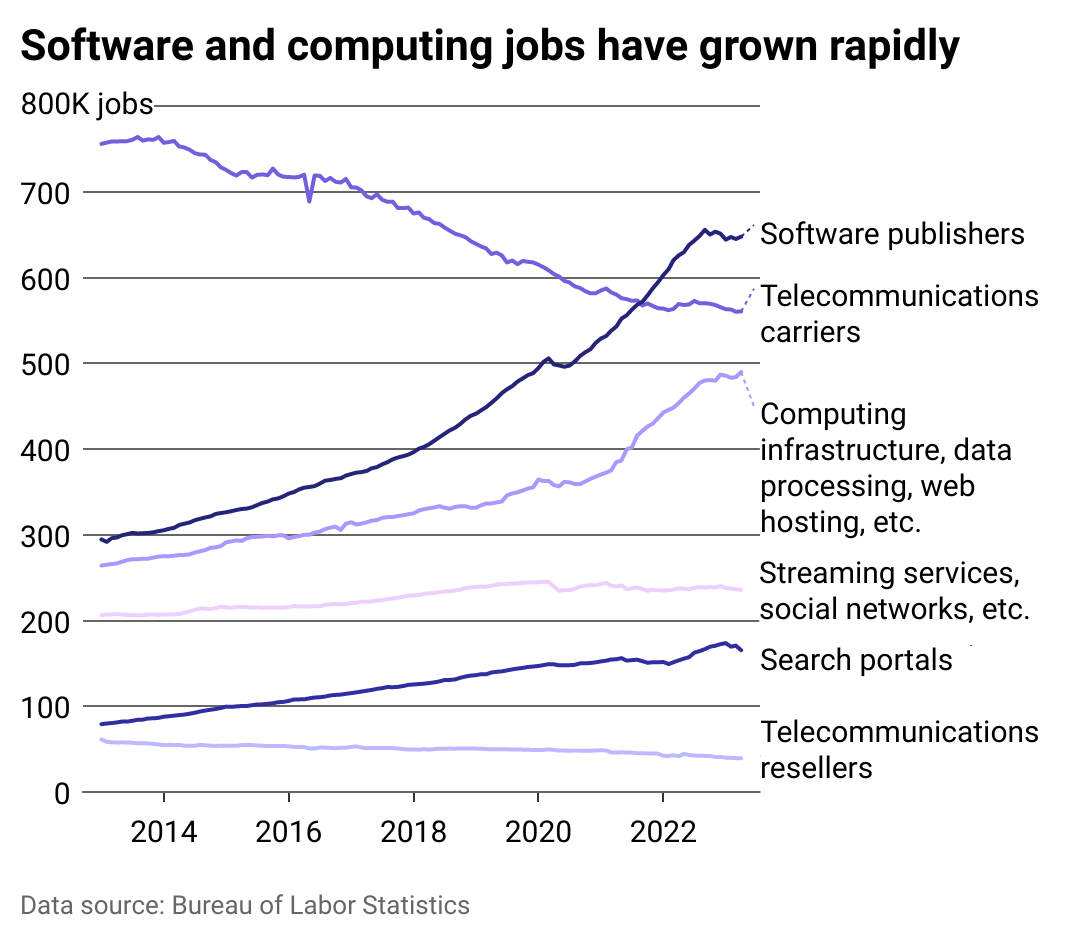In with software, out with telecommunications: How employment in 6 tech industries has changed since 2013
Indypendenz // Shutterstock
In with software, out with telecommunications: How employment in 6 tech industries has changed since 2013
Programmer working on on desktop programming code.
What a difference a decade can make. Those on the job hunt may discover that in-demand skills can shift seemingly overnight as industries react and adapt to market conditions. Highly sought-after skillsets in a hot sector today may change if an industry is offloading jobs tomorrow.
The telecommunications and technology industries are prime examples. According to the Bureau of Labor Statistics, between January 2013 and April 2023, the telecom sector, which builds the infrastructure required to use networked technology, lost over 217,000 jobs, while the tech sector—software, search engines, social media, and computing infrastructure—added nearly 695,000 jobs. The decade has also seen the rise of new technologies and tools that have created hiring demands at tech companies while creating efficiencies at telecom companies that require fewer employees.
That said, many big tech companies such as Meta, Google, Amazon, Zoom, and Microsoft have announced major layoffs this year after ramped-up hiring during the pandemic. Through April 2023, job losses in the tech sector number over 176,000, according to TechCrunch.
Despite current struggles in the tech economy, jobs with software publishers have grown over seven times faster than jobs in the overall private industry. However, it remains to be seen what job shifts are in store for the tech sector. To that end, Revelo analyzed employment using Bureau of Labor Statistics data about various technology subsectors to see how the industry has changed over the past decade.
Looking ahead, today’s new technologies will only be hot for about 2.5 years before the next ones come along, Mike Bechtel, chief futurist at Deloitte Consulting, told CIO.com earlier this year. So employees need to be flexible and adapt to keep up with the needs of the industry.
![]()

Revelo
Jobs have grown in most tech industries
A multiline chart showing the total jobs over time in 6 technology industries.
In 2013, the telecom and tech industries were much closer in their levels of employment. The telecom industry employed 817,000 workers, while tech companies employed nearly 844,000 workers. Fast-forward a decade, and the tech sector employs over 2.5 times the number of telecommunications workers.
One primary reason the telecommunications industry has shed workers is that companies within this sector have changed how they use technology. Workers once used equipment to operate networks, but now automation, software, and cloud-based tools do the same work more efficiently with fewer people.
That’s not to say that telecom employment is in freefall—the skillset has just shifted. Telecom companies no longer need as many employees at headquarters to do administrative and management roles, Sean McDevitt, partner at telecom consulting firm Arthur D. Little, told fiercetelecom.com.
However, they do need crews who build and deploy fiber and broadband networks. This was particularly apparent during the pandemic as work-from-home employees sapped the bandwidth of home-based networks, requiring telecom companies to make upgrades. Demand for field crews is still high, as companies need these workers to strengthen their network capabilities.
In the technology sector, job growth started increasing in 2011 after a rough decade following the dot-com implosion, which decimated the industry. It took until 2021 to replace all of the jobs that had been lost, the New York Times reports. During that time, companies like Zoom and Slack grew from nothing—they launched in 2011 and 2014, respectively—to become vital workplace tools keeping employees connected. Cloud computing changed how companies store and access data. Social media platforms like Snapchat soared while others crashed. (Remember Google+?)
In 2023, digitalization and AI are key technologies driving employment growth in the tech sector, CIO.com reports. Digitalization uses technology to process a company’s data to new insights and find opportunities for growth and change. Of course, workers need to create these tools.
AI may take over what entry-level and low-level employees currently do. Automating low-level tasks, including coding, is changing job functionality across industries and within the tech sector itself. AI also enables more automation and allows employees to be more productive, meaning workers will have to know how to leverage AI as well as be able to manage higher-level tasks.
This is affecting employment among software engineers, Vox.com reports, normally a job that’s continually in demand in the tech industry. Although the software publishing sector gained 351,000 jobs from April 2013 to April 2023, it has declined since September 2022, losing 7,900 jobs.
While there is no predicting how career headwinds will shift in the tech industry, skilled professionals ready to stay flexible and adaptable will likely be best positioned for what lies ahead.
Story editing by Ashleigh Graf. Copy editing by Kristen Wegrzyn.
This story originally appeared on Revelo and was produced and
distributed in partnership with Stacker Studio.
